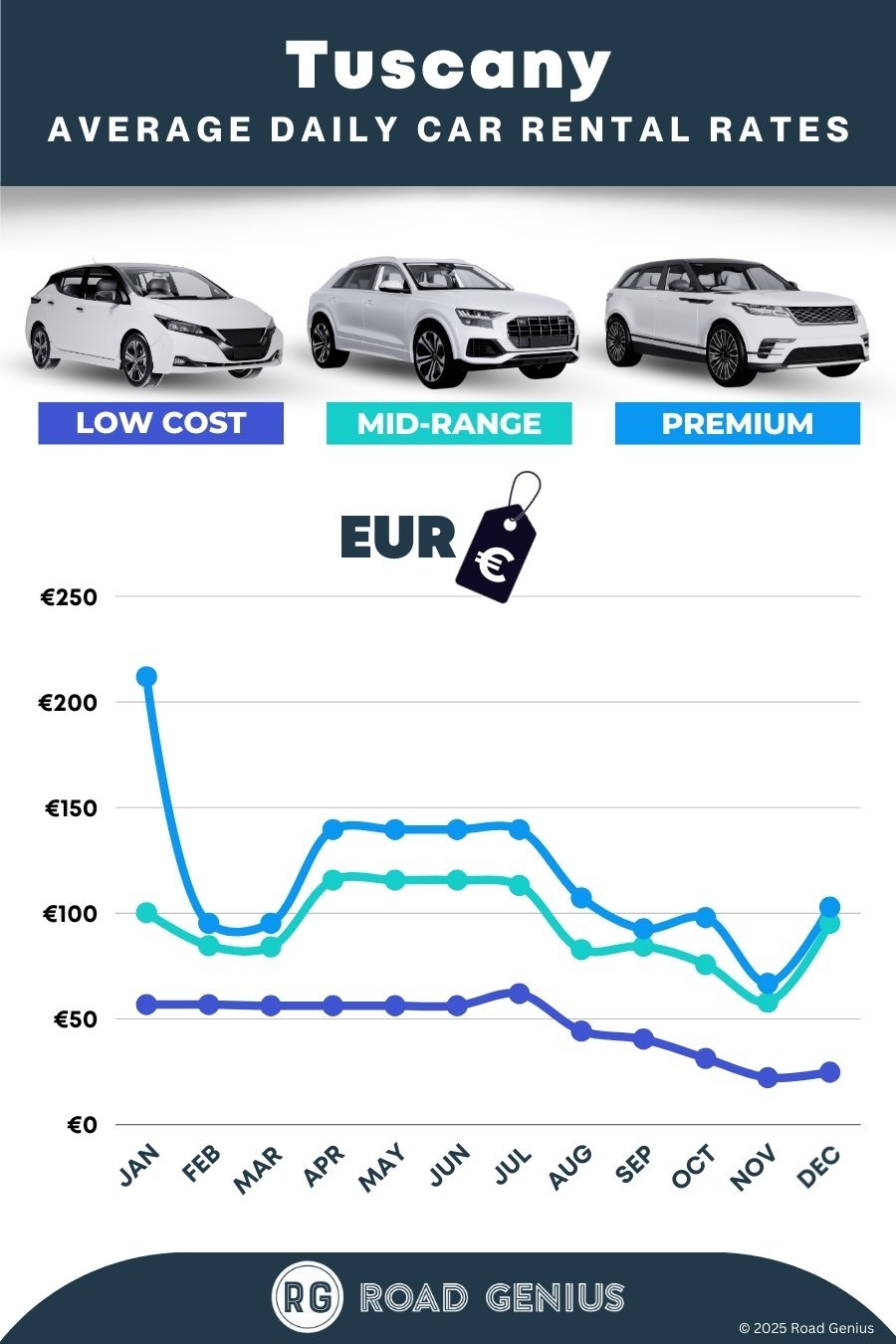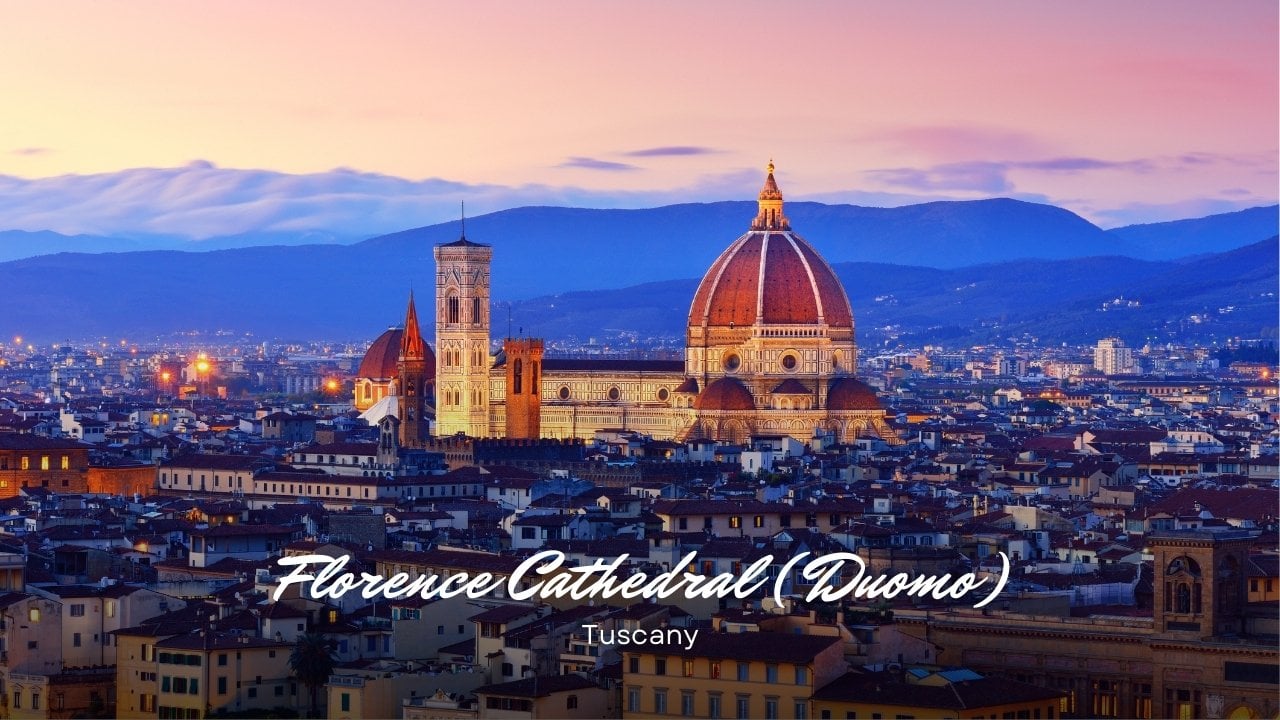






Finding a rental car in Tuscany is easier with Road Genius. Compare prices from dozens of brands all around Italy with no booking fees. Pick up your rental car at Florence Airport or Pisa Airport for the widest choice and longer opening hours, or choose Florence city locations to avoid airport surcharges. Plan ahead for ZTL zones in centers and book an automatic early for summer drives through Chianti and the Val d’Orcia.
Tuscany offers several options for renting a car:
| Location | 👍 Pros | 👎 Cons |
|---|---|---|
| Florence Airport (FLR) | • Largest selection in Tuscany • Extended opening hours • Easy motorway access • All major companies |
• Airport surcharge (approximately 16%) • Traffic congestion leaving Florence • ZTL zones to navigate if staying in city |
| Pisa Airport (PSA) | • Good selection of vehicles • Extended hours • Convenient for western Tuscany |
• Airport surcharge • Further from eastern Tuscany • Distance from Florence |
| Florence City | • No airport surcharge • Convenient if already in Florence • Multiple locations |
• Limited operating hours • Smaller selection • ZTL navigation challenges |
| Siena/Arezzo/Other Tuscan Cities | • More convenient for starting from these locations • No airport surcharge • Less traffic to navigate |
• Very limited selection • Restricted operating hours • Advance reservation essential • Often closed Sundays |
On average, car rentals in Tuscany cost around €87 per day, with the lowest-priced rentals available from €22 per day.
Compare pickup locations. City pickups in Florence, Siena or Lucca avoid the ~16% airport surcharge. Airports have longer hours and more automatics, so compare total cost and convenience.
Time your booking smartly. For peak periods like July–August, Easter and Siena’s Palio, book 2–3 months ahead. In low season, grab a free-cancellation rate and recheck prices closer to the date.
Pick a smaller, manual car. Economy/compact and manual transmissions are cheaper, use less fuel and fit Tuscan parking better than larger cars. Automatics cost 30–50% more.
Tweak dates and routing. Check 5–7 day “weekly” deals and adjust pickup/return times to avoid paying an extra day. One-way within Tuscany is often low or free, which can save on backtracking fuel and tolls.
Skip paid extras. Use your phone for navigation instead of hiring a sat nav. Bring child seats for longer rentals. Add only one driver unless a capped fee makes sense.
Cut road costs and avoid fines. Use the free FI-PI-LI between Florence and Pisa/Livorno when it suits instead of the tolled A11. Refill near drop-off and keep the receipt. Park outside ZTLs to avoid fines. Local tips: Pisa’s Via Pietrasantina for the Tower, Siena’s Santa Caterina or Stadio car parks with escalators.

Almost all Tuscan historic centers have ZTL restrictions:
| City | ZTL Features | Parking Alternatives |
|---|---|---|
| Florence | • Extensive central zone • Active weekdays 7:30-19:30 • Limited weekend hours • Strictly enforced |
• Fortezza da Basso garage • Piazzale Michelangelo (view of city) • Train station area (Porta al Prato) |
| Siena | • Entire historic center • 24/7 enforcement in central areas • Camera system at all gates |
• Santa Caterina (escalators to the center) • Stadio/Fortezza parking lot • Il Campo garage |
| Lucca | • All areas inside Renaissance walls • Active daily • Pedestrian/cycling focus |
• Spots outside walls (Carducci, Mazzini) • Some free areas (Via delle Tagliate) |
| Pisa | • Historic center and Tower area • 24/7 in many areas • Divided into multiple zones |
• Via Pietrasantina parking lot (for Tower) • Pisa Central Parking (near station) |
| San Gimignano | • Historic center inside walls • Active daily |
• P1, P2, P3, P4 parking lots outside walls • Fill early in high season |
| Montepulciano | • Hilltop historic center • Limited hours |
• Spaces at bottom of hill • Shuttle service in summer |
ZTL Fine Prevention:
| Parking Type | Common Locations | Tips |
|---|---|---|
| Municipal Parking Lots | Outside historic centers of all towns | • Blue "P" signs show location • Usually paid hourly • Often less expensive than private garages |
| Street Parking | Outside ZTL zones | • Blue lines = paid • White lines = free or residents only (check signs) • Yellow lines = restricted (no parking) |
| Private Garages | Major cities and towns | • More expensive but covered/secure • Good for overnight or poor weather • Some offer advance booking |
| Free Peripheral Parking | Outskirts of smaller towns | • Limited spaces, fill early • May require uphill walk to the center • Best in off-season or early morning |
Tips for Finding Spots:
Some meters require license plate entry, have plate number ready.
Speed Limits:
Get a rental car so you can see:
Val d'Orcia - Montalcino, Pienza, Montepulciano
Chianti Wine Road (SR222) - Greve, Panzano, Castellina, wineries
Crete Senesi and Val di Merse - Asciano, San Giovanni d'Asso, San Galgano, Monte Oliveto Maggiore
Etruscan Coast - Livorno, Bolgheri, Castagneto Carducci, Suvereto
Garfagnana and Apuan Alps - Lucca, Bagni di Lucca, Barga, Carrara
San Gimignano and Volterra

Do I need an International Driving Permit in Tuscany? If you're from a non-EU country like the USA, Canada or Australia, you need an International Driving Permit plus your home driver's license. UK visitors who have a photocard license don't need an IDP for Italy.
What are the "strade bianche" I hear about in Tuscany? "Strade bianche" are the unpaved white gravel and dirt roads you find in country Tuscany. They are part of the landscape and might show up on your GPS. However, most car rental companies don't let you drive on these unsealed roads. If you break this rule, the company could give you a big fine or cancel your insurance. Always check your rental contract to see what roads you can't drive on. These roads can also be tricky to drive on, especially when it's been raining.
How do I avoid ZTL fines in Tuscan cities? Never drive into historic centers without permission. Look for blue "P" signs that show you legal parking areas outside the restricted zones. If your hotel is inside a ZTL, contact the staff beforehand so they can register your license plate. If you're not sure, it's best to park outside the zone and walk or use public transport.
Is driving in Tuscany difficult for tourists? People keep the main roads in Tuscany in good shape and they are clearly marked. You need to pay more attention when you drive on country roads or in hill towns because the roads are narrow and winding. The biggest challenges for tourists are dealing with ZTL zones in cities and finding parking in popular towns during peak season. If you do a little planning, you'll probably find driving in Tuscany is fine.
What's a recommended scenic drive in Tuscany for first-time visitors? For a classic Tuscan view, we recommend the Val d'Orcia loop south of Siena. The route goes through Montalcino, Pienza and Montepulciano. You'll see rolling hills, roads lined with cypress trees and medieval towns. The Chianti wine road (SR222) between Florence and Siena is another popular drive.
Can I visit multiple hill towns in one day? Yes, if you have a rental car you can usually visit two or three towns in a day. It just depends on how far apart they are and how long you stay in each place. For example, you could easily visit San Gimignano and Volterra together, or Montalcino and Pienza. Remember to leave time for parking, walking in pedestrian-only areas and stopping for photos between towns.
When is the best time to drive in Tuscany? The best months are usually May, June, September and early October. At this time, you'll get pleasant weather, the traffic isn't too bad and the scenery is beautiful. In July and August, you'll find more traffic and it's harder to find parking in popular towns. In spring, you'll see green hills and wildflowers, while in autumn you can see the harvest and the changing colors.
Is it worth renting a car just to explore the Tuscan countryside for a day? Yes. Even if you only have one day, a rental car lets you see the Tuscan landscape and visit towns that are hard to get to using public transport. Many rental companies have daily rates. Plus, you get the freedom to stop at viewpoints, wineries and small villages, which many travelers appreciate.